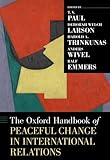The Oxford Handbook of Peaceful Change in International Relations / edited by T. V. Paul, Deborah Welch Larson, Harold A. Trinkunas, Anders Wivel, and Ralf Emmers.
Material type: TextSeries: Oxford handbooksPublisher: New York: Oxford University Press, [2022]Description: xiii, 819 pages ; 26 cmContent type:
TextSeries: Oxford handbooksPublisher: New York: Oxford University Press, [2022]Description: xiii, 819 pages ; 26 cmContent type: - text
- unmediated
- volume
- 9780190097356
- 327.1/72 23
- JZ5560 .O98 2022
| Item type | Current library | Collection | Call number | Copy number | Status | Notes | Barcode | |
|---|---|---|---|---|---|---|---|---|
 Books
Books
|
Zayed Military University General Stacks | General Collection | JZ5560 .O98 2022 (Browse shelf(Opens below)) | C. 1 | Available | AED 508.20 | 22866 |
Includes bibliographical references and index.
"Abstract: With the rapid rise of China and the relative decline of the United States, the topic of power transition conflicts is back in popular and scholarly attention. The discipline of International Relations offers much on why violent power transition conflicts occur, yet very few substantive treatments exist on why and how peaceful changes happen in world politics. This Handbook is the first comprehensive treatment of the subject of peaceful change in International Relations. It contains some 41 chapters, all written by scholars from different theoretical and conceptual backgrounds examining the multi-faceted dimensions of this subject. In the first part, key conceptual and definitional clarifications are offered and in the second part, papers address the historical origins of peaceful change as an International Relations subject matter during the Inter-War, Cold War, and Post-Cold War eras. In the third part, each of the IR theoretical traditions and paradigms in particular Realism, liberalism, constructivism and critical perspectives and their distinct views on peaceful change are analyzed. In the fourth part papers tackle the key material, ideational and social sources of change. In the fifth part, the papers explore selected great and middle powers and their foreign policy contributions to peaceful change, realizing that many of these states have violent past or tend not to pursue peaceful policies consistently. In part six, the contributors evaluate the peaceful change that occurred in the world's key regions. In the final part, the editors address prospective research agenda and trajectories on this important subject matter. Keywords: Peaceful Change; War; Security; International Relations Theory; Sources of Change; Systemic Theory; Realism; Liberalism; Constructivism; Critical Theories"-- Provided by publisher.
There are no comments on this title.
